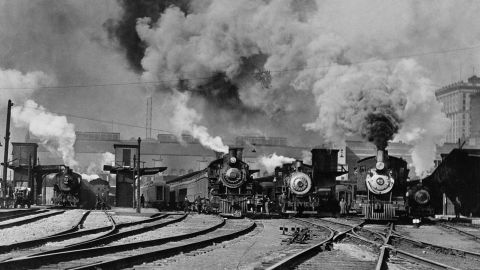Most labor disputes never end up being debated in Congress. But thanks to a nearly century-old law that regulates labor relations only when it comes to railroads and airlines, what otherwise would be strictly an economic issue became a political one.
The Railway Labor Act was passed in 1926 as one of the very first labor laws in the nation. At that point most of the railroads already had been unionized, some all the way back to the mid-19th century. The structure was therefore set up to regulate labor negotiations between unions and management, rather than oversee organizing campaigns for new unions and additional members.
Because of the law, the House was able to vote Wednesday to impose unpopular contracts on four rail unions whose members have already rejected the terms, followed by a vote by the Senate vote late Thursday that did the same.
The measure now goes to President Joe Biden, who has said he will sign it. When he does, there will no longer be a chance of a Dec. 9 strike that would have shut down about 30% of the nation’s freight shipments. A prolonged strike would have caused shortage of a wide range of items, from food to gasoline to automobiles, and likely resulted in a spike in prices.

A group of steam locomotives pour steam and smoke into the air in St. Paul, Minnesota in this file photo from 1925. The Railway Labor Act, passed in 1926, is the reason Congress could intervene this week to block a strike by freight railroad unions.
The House also passed a law that would give the unions paid sick days, addressing the issue they said led members to reject the deals. But the efforts to pass that same measure in the Senate fell short, even though 52 of 95 senators voted for it. The measure needed 60 votes to pass the senate.
Under the Railway Labor Act, the federal agency that oversees railroad and airline labor relations is the National Mediation Board, which tries to bring the two sides together, and it set up a series of limits and cooling off periods during which unions can not strike and management can not lock out the workers. And if all those efforts fail, then Congress can step in and impose a contract under which both sides will have to operate.
In negotiations at other businesses, the workers’ ability to strike is the most powerful option unions have to achieve their goals at the bargaining table. And even the railroads admit that the law makes strikes extremely unlikely.
“The goal of the Railway Labor Act was to reduce the likelihood of a work stoppage,” said Ian Jefferies, the CEO of the Association of American Railroads, the trade group that represents the railroads. “And it’s been remarkably effective in doing that.”
As much as management likes the law and its limits on strikes, the unions hate it. They say it would be far easier to reach a deal that their members can support if they had the leverage of a possible strike. And they say that management, when weighing the cost of that possible strike, would realize that they have the resources needed to meet those demands without an actual work stoppage.
The four major railroads — Union Pacific (UNP), CSX (CSX), Norfolk Southern (NSC) and Berkshire Hathaway (BRKA)’s Burlington Northern Santa Fe — reported some form of record profits in 2021. Wall Street analysts expect even better profits in 2022, at least for the three railroads they cover.
If they were covered by the National Labor Relations Act, the labor law that oversees worker-management relations at most of the nation’s businesses, the unions could threaten to go on strike. But under the Railway Labor Act, management can fall back on hopes that Congress will give them the deal it wants.
“This action prevents us from reaching the end of our process, takes away the strength and ability that we have to force bargaining or force the railroads to…do the right thing,” said Michael Baldwin, president of the Brotherhood of Railroad Signalmen, one of the four unions whose members voted against the tentative agreements reached last fall that Congress is now poised to impose on members.
The railroads deny they wanted this to end up with Congress, and they preferred to reach a deal with the unions that could be ratified by membership.
“I don’t think it’s anyone’s goal to get Congress involved, but Congress has shown a willingness historically to intervene if necessary,” said AAR’s Jefferies.
But Biden, in his statement calling on Congress to act to impose the rejected tentative agreements on the rail workers to keep them on the job, seemed to acknowledge that there was no chance that rail management would reach a deal with the unions.
“During the ratification votes, the Secretaries of Labor, Agriculture, and Transportation have been in regular touch with labor leaders and management,” he said. “They believe that there is no path to resolve the dispute at the bargaining table.”
The railroads refused to accept union demands for paid sick days. Jefferies also said the railroads would only agree to make changes in sick day rules if it was within the “framework” of the proposal put forth by a presidential panel this summer that was charged with trying to find a compromise agreement.

America may dodge a crippling rail strike. Here’s how we got here
That means for the unions to get the sick pay they wanted, they’d have to give up some other pay or benefit in order to keep the overall economics of the package unchanged. The likelihood that Congress will impose a deal along the lines of the presidential panel’s recommendations, or the tentative agreements, means that management has little incentive to agree to union demands.
The decision to urge Congress to take action was politically difficult for Biden, who is often referred to as the most pro-union president in recent history. When he served in the Senate, Biden voted against an earlier effort to impose a contract on the rail unions to keep them on the job.
“As a proud pro-labor President, I am reluctant to override the ratification procedures and the views of those who voted against the agreement,” he said in his statement Monday night calling for Congressional action.
But he said he couldn’t ignore the economic upheaval that a rail strike could cause, and that he had no choice but to turn to Congress and the powers it has.
“In this case – where the economic impact of a shutdown would hurt millions of other working people and families – I believe Congress must use its powers to adopt this deal,” he said.
And he said the deals, while they weren’t everything the unions wanted, were good ones for the unions, with the biggest pay increases in more than 50 years, and some improvements in other contract terms.
“On the day that it was announced, labor leaders, business leaders, and elected officials all hailed it as a fair resolution of the dispute between the hard-working men and women of the rail freight unions and the companies in that industry,” Biden said. “The agreement was reached in good faith by both sides.”
But the unions and their allies say that it’s wrong to force members to accept a deal they rejected because it denies the workers the basic sick days they are demanding.
“During the first three quarters of this year, the rail industry made a record-breaking $21.2 billion in profits,” said a group of a dozen Democratic senators, led by Sen. Bernie Sanders. “Guaranteeing seven paid sick days to rail workers would only cost the industry $321 million a year – less than 2 percent of their total profits. Please do not tell us that the rail industry cannot afford to guarantee paid sick days to their workers.”
But only 4 of the 12 senators who issued the statement - Sanders, Kirsten Gillibrand of New York, Jeff Merkley of Oregon and Elizabeth Warren of Massachusetts - voted against imposing the unpopular contracts. The other eight who signed onto the statement - Tammy Baldwin of Wisconsin, Cory Booker of New Jersey, Sherrod Brown of Ohio, Ed Markey of Massachusetts, Alex Padilla of California, Tina Smith of Minnesota and Jack Reed and Sheldon Whitehouse of Rhode Island - all joined in the 80-15 vote in favor of imposing the contracts to block the strike.